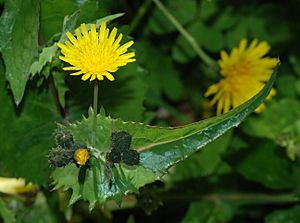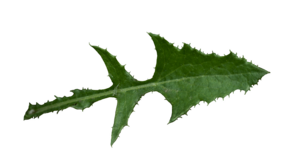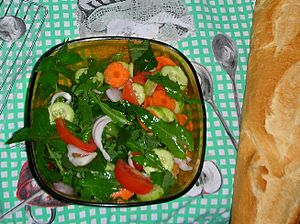Common sowthistle facts for kids
Quick facts for kids Common sowthistle |
|
|---|---|
 |
|
| Scientific classification | |
| Genus: |
Sonchus
|
| Species: |
oleraceus
|
The Common Sowthistle (scientific name: Sonchus oleraceus) is a type of flowering plant. It belongs to the Asteraceae family, which also includes sunflowers and daisies. This plant is originally from Europe and Western Asia.
It has many other common names. People sometimes call it 'sow thistle', 'smooth sow thistle', or 'annual sow thistle'. It's also known as 'hare's colwort' or 'hare's thistle'. The name 'sow thistle' comes from the fact that pigs really like to eat it. 'Hare's thistle' is because people believed it was good for hares and rabbits. The scientific name oleraceus means "vegetable" or "herbal" in Latin.
Contents
What Does Common Sowthistle Look Like?
This plant grows every year, meaning it lives for only one growing season. It has a hollow stem that stands straight up, usually reaching about 30 to 100 centimeters tall. That's like a meter stick!
Common sowthistle likes sunny places. It can grow in most types of soil. Its flowers have both male and female parts. Bees and flies often help to pollinate them. The plant spreads its seeds easily. The wind or water carries the seeds to new places.
Where Does Common Sowthistle Grow?
While native to Europe and Asia, this plant has spread to many other parts of the world. In some places, it is considered an invasive species. This means it grows very quickly and can take over areas, especially disturbed land. For example, in Australia, it can become a big problem in farm fields.
Can You Eat Common Sowthistle?
Yes, you can! The leaves of the Common Sowthistle are edible. People eat them in salads or cook them like spinach. In Chinese cooking, it's known as kŭcài, which means "bitter vegetable."
Younger leaves are usually less bitter and taste better when eaten raw. If you have older leaves, steaming them can help remove some of the bitterness. Even the younger roots can be eaten. Some people use them as a substitute for coffee!
Nutrients in Common Sowthistle
Common Sowthistle is quite nutritious! Here's what you might find in 100 grams of its leaves:
- Vitamins:
* Vitamin C: 30-40 mg * Vitamin A: 35 mg * Thiamine (B1): 1.5 mg * Riboflavin (B2): 5 mg * Niacin: 5 mg
- Minerals:
* Calcium: 1500 mg * Phosphorus: 500 mg * Iron: 45.6 mg
- Other:
* Protein: 1.2% * Fat: 0.3% * Carbohydrates: 2.4%
Common Sowthistle in Traditional Medicine
People have used Common Sowthistle in herbal remedies for a long time. It is thought to have similar health benefits to plants like dandelion.
The early Māori people in New Zealand likely gathered this plant for both food and medicine. Native Americans also used it in many ways. For example:
- The Pima people used its sap as a medicine and ate the leaves and stems.
- The Yaqui people boiled the young leaves with chile and ate them as greens.
- The Kamia (Kumeyaay) people boiled the leaves for food.
- The Houma people used it to help with diarrhea and for teething babies. They also fed it to their hogs.
How to Control Common Sowthistle
If this plant grows where it's not wanted, like in a garden, it can often be controlled by mowing. This is because it doesn't grow back from small pieces of its roots. Sometimes, using herbicides (weed killers) too much can actually make the problem worse in some areas.
See also
 In Spanish: Cerraja común para niños
In Spanish: Cerraja común para niños




